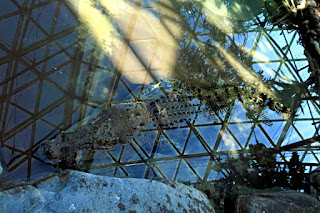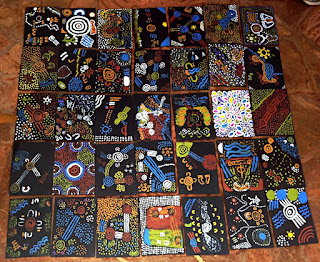A little bit of this, a little bit of that
Friday, Oct. 14
 |
| The Twelve Apostles. All the photos in this post are random -- not related to any of the text |
The flight home
I won’t go into
the trip home except to say that fewer people are heading to America
than we came over with, so the flight attendants encourage the
passengers to spread out. This time a young man is seated in our row,
taking the window seat. The flight attendants tell us several times
that we can feel free to spread out and take one of the empty seats.
They start out addressing their comments directly to him and then
mention that we can move if we want to. Obviously, they're trying to
keep us together. But the young man shows no inclination to move.
Finally, Sharon
decides to move to another seat so she'll have enough room to work on
her quilt. She's in the middle seat, so I have to get up to let her
out. By the time I'm ready to return to my seat, the kid has flipped
up the arm next to him and stretched out across the middle seat, with
his feet hanging down in front of my seat.
I don't stay long
before another attendant tells me there's an empty row by the rear
exit door of the plane. I decide to take her up on the offer. It's
wonderful. I have all kinds of space, and I'm right next to the
galley.
When it comes time
to return to my assigned seat for landing, the kid has taken over the
entire row and scattered belongings and trash throughout the area. He
doesn't seem happy when I come back and make him move.
 |
| Kookaburra |
The people
I’m impressed with
the Aussies we run into. By and large they’re friendly and
accommodating, and many of the ones we talk to seem genuinely
concerned that we are having a good trip and enjoying their country.
And the phrase “No worries, mate” doesn't seem to be just a
saying; It’s an attitude.
You'll notice that I've posted no pictures of Aboriginal people. We were told they don't like having their photos taken -- as much to avoid just being curiosities for the tourists as anything else, I expect -- but would sometimes allow it if they were asked. I decided to respect their desire for privacy and didn't ask.
 |
| One of Aaron's pictures of Brandon feeding a wallaby. |
The language
No real barriers to
communication with people who share the same root language. You do
hear all the expressions you've learned from the movies, with a
couple of exceptions. During our time I never heard anyone utter the
word “crikey.” Doesn't mean they don't say it, but we weren't in
situations where it arose. Yes, "mate" is used extensively, and it turns out to be gender neutral.
Also, the only time
I heard “sheila” was in a discussion one member of our group was
having with Tony. I think we were in a roadhouse and the toilets, the
most common word instead of our multitude of euphemisms, were labeled
“blokes” and “sheilas.” Seemed kinda kitschy to me, like
labeling restrooms in Mexican food place with “caballeros” and
“damas,” or the seemingly infinite variety of labels you can
encounter in barbecue joints.
One last foodie
break
The Aussies have
this concoction they developed called vegemite. The English have
something similar called marmite, which Aussies used to eat before
the big war. But the war disrupted shipments, so the Aussies came up
with their own version.
 |
| Aussie humor |
This has to be the
nastiest concoction I believe I’ve ever tasted. It's made from
leftover yeast extract used in brewing beer along with some spices,
salt and other stuff. I gather the exact makeup is a secret, like
Colonel Sanders’ spices or Dr Pepper’s flavors.
I was once asked how
overly sugary stuff tastes to me since my sense of taste was altered
but couldn’t explain because I had no frame of reference. If I were
asked now, I’d refer to vegemite, though that might not translate
to anyone who’s ever tasted vegemite because I don’t know what
that tastes like to them.
According to Tony,
vegemite is an acquired taste, as in growing up with the stuff being
fed to you your entire childhood can cause you to acquire the taste.
Of course I’d wager that almost everyone has some food they grew up
with they won’t touch now. For me it's rutabagas. Didn’t like it
then and still don’t. He also says the best way to eat it is to
take a thick slice of bread, toast it, spread a generous amount of
butter on it and then add a thin layer of vegemite on top of that. If
you're curious, the boys tried it that way and still didn’t like
it.
I think I mentioned
that catsup is called “tomato sauce,” and you get take-away food,
not to go. The one puzzler, if it hadn't been pointed out to us,
would have been “capsicum,” what we would call bell pepper.
I once produced a
parody of the Dos Equis' Most Interesting Man in the World in which I
said, “I don't often drink beer, but when I do, I prefer whatever
someone else is buying.” Several of our group meals have drinks
included, and I take the opportunity to try the beers. I'm sure they
were all major-brand, run of the mill beers, but I like all the ones
I tried. Still, I'm no connoisseur. Tony doesn't seem to think much
of them. The boys try out a brand that Tony likes and seem to agree
it's better than the other brands we've sampled.
 |
| One of 72 fish sculptures created for the 2006 Commonwealth Games. Each country was represented by a different species of fish. They are scattered around Melbourne; this one is near our hotel. |
Architecture
The people who
colonized Australia, convicts and officials sent with them to
maintain control, were Brits. This explains why in a country so vast,
with room to spread out, the older parts of cities are dominated by
narrow roads and houses in the Victorian style, crammed together with
postage stamp yards. I suspect this is less true in the newer
suburbs, but like anywhere, the more property you want for your
homestead, the more it’ll cost you.
But even taking into
consideration the difference in the exchange rate, average home costs
in the urban areas we visited seem to be higher than a comparable
home would be in Dallas-Fort Worth. I could be mistaken about that
given my limited perceptions, but I often wonder, after hearing Tony
talk or seeing an item on the news, just how in the world people
afford to live there. Maybe the average wages are better.
Money
The smallest
denomination bill the Aussie print is a fiver. They mint coins in 5
cent, 10 cent, 20 cent and 50 cent versions, each distinctly
different from each other. And they mint $1 and $2 coins. The bills
are different sizes, with the $5 being the smallest and the $50 the
largest. I'm sure they have bigger denomination bills, but these were
the ones we always worked with. The bills are made from plastic, I
think, and some of them have clear sections. Aaron received a fiver
that had large, clear sections in it and said he heard they don't
work well in vending machines.
A ten-percent tax is
built into the cost of everything you buy, and because they don't
have pennies, any price that works out to less than a multiple of
five is rounded. This happens frequently in the grocery stores, where
produce is priced by the pound, and the sale price of our TimTams
came out to A$1.83. On one of our shopping trips, I miscalculated the
price, and rounding up put it a nickel past the amount of change in
my pocket. While I was reaching for a fiver to substitute for all the
coins, the checker dug in his pocket and supplied the nickel. What a
nice guy.
The end
So, that was our
trip, more or less. I'm sure I've left a multitude of items out. Now,
looking back, it's almost a dream, one I would mind having again, but
we have so much more to explore, so unless someone wants to start a
Go Fund Me just to get me out of the country again, I expect we'll
move on to other adventures.
 |
| Bondi Beach |





























